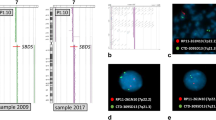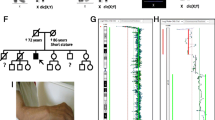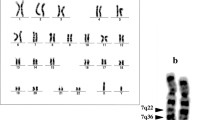Summary
Nine patients with transient myeloproliferative syndrome (TMS) with or without Down syndrome (DS) phenotype were studied cytogenetically, particularly with regard to the origin of trisomy 21. Of six DS patients, five had standard trisomy 21 and one a mosaic consisting of 21-tetrasomic, trisomic and disomic cell lines. The other three non-DS patients were mosaics with both 21-trisomic and-disomic cell lines. In all nine patients, the leukemoid cells in TMS stage were largely or exclusively composed of trisomy or tetrasomy 21, an indiction that the additional chromosome(s) 21 plays an important role in the occurrence of TMS. Sequential Q-and R-banding analysis of heteromorphisms demonstrated that all these patients had a duplication of a chromosome 21, as revealed by an “aab” pattern, regardless of DS or normal phenotype or parental origin of the extra chromosome 21. Irrespective of the possibility of recombination, the “aa” chromosomes are homozygous, i.e. show disomic homozygosity: this may in turn result in the duplication of a gene that controls the proliferation of the myelogenous cells, thereby leading to TMS.
Similar content being viewed by others
References
Atkin NB, Baker MC (1988) Small metacentric marker chromosomes, particularly isochromosomes, in cancer Hum Genet 79: 96–102
Bennett JM, Catovsky D, Daniel M-T, Flandrin G, Galton DAG, Gralnick HR, Sultan C (1985) Criteria for the diagnosis of acute leukemia of megakaryocyte lineage (M7). A report of the French-American-British cooperative group. Ann Intern Med 103:460–462
Human Gene Mapping 9 (1987) 9th International Workshop on Human Gene Mapping. Cytogenet Cell Genet 46:1-762
Juberg RC, Mowrey PN (1983) Origin of nondisjunction in trisomy 21 syndrome: all studies compiled, parental age analysis, and international comparisons. Am J Med Genet 16:111–116
Lampkin BC, Bove KE, Peipon JJ, Arivastava AK, Price JK, Jones MM (1985) Spontaneous remission of presumed congenital acute nonlymphoblastic leukemia (ANLL) in a karyotypically normal neonate. Am J Pediatr Hematol Oncol 7:346–351
Lilleyman JS (1980) Congenital monocytic leukemia. Clin Lab Haematol 2:243–245
Morgan R, Hecht F, Cleary ML, Sklar J, Link MP (1985) Leukemia with Down's syndrome: translocation between chromosomes 1 and 19 in acute myelomonocytic leukemia following transient congenital myeloproliferative syndrome. Blood 66:1466–1468
Niikawa N, Kajii T (1984) The origin of mosaic Down syndrome: four cases with chromosome markers: Am J Hum Genet 36:123–130
Rogers PCJ, Thomas JW, Kalousek DK, Baker MA (1983) Neonate with Down's syndrome and transient congenital leukemia. In vitro studies. Am J Pediatr Hematol Oncol 5:59–64
Seibel NL, Sommer A, Miser J (1984) Transient neonatal leukemoid reactions in mosaic trisomy 21 J Pediatr 104:251–254
Stewart GD, Hassold TJ, Berg A, Watkins P, Tanzi R Kurnit DM (1988) Trisomy 21 (Down syndrome): studying nondisjunction and meiotic recombination by using cytogenetic and molecular polymorphisms that span chromosome 21. Am J Hum Genet 42: 227–236
Van Eys J, Flexner JM (1969) Transient spontaneous remission in a case of untreated congenital leukemia. Am J Dis Child 118:507–514
Zipursky A, Peeters M, Poon A (1987) Megakaryoblastic leukemia and Down's syndrome — a review. In: McCoy EE, Epstein CJ (eds) Oncology and immunology of Down syndrome. (Progress in clinical and biological research) Liss, New York, pp 33–56
Author information
Authors and Affiliations
Rights and permissions
About this article
Cite this article
Abe, K., Kajii, T. & Niikawa, N. Disomic homozygosity in 21-trisomic cells: a mechanism responsible for transient myeloproliferative syndrome. Hum Genet 82, 313–316 (1989). https://doi.org/10.1007/BF00273988
Received:
Revised:
Issue Date:
DOI: https://doi.org/10.1007/BF00273988




